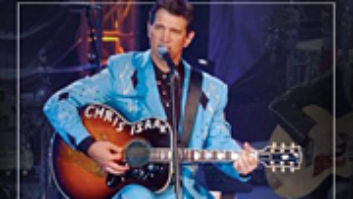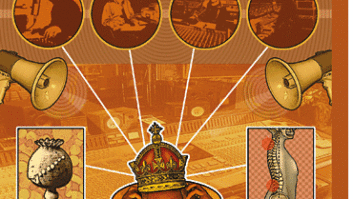The late engineer/producer/rock ‘n’ roll pioneer Sam Phillips said, “There’s music in voice. If you feel it and it’s a part of your spirituality, there is nothing as beautiful as the human voice.” Certainly, it’s hard to think of anything more beautiful than the voice of Roy Orbison, one of Phillips’ discoveries in the days of the Memphis Recording Service. Orbison’s career spanned more than four decades, and his voice just seemed to get better and more poignant as the years passed.
“No matter what period of his life he was in, he just had a voice like a bird,” says engineer Noa Lazerus, “and all of the live performances are so impressive because he’s so present, with that mysterious operatic voice that he had in rock.” Lazerus is one of the engineers at Chace Productions, where the audio for Roy Orbison’s Greatest Hits DVD was recently produced. The disc includes film of performances dating back to the ’50s and on through Orbison’s career, culminating in the ’80s with footage from the artist’s famed Austin City Limits appearance and the Black & White Night live album produced by T-Bone Burnett. The performances are interwoven with tape of Orbison speaking to a camera, relating tales and memories from his career. It’s a fan’s dream but a post engineer’s nightmare: Sources ranged from multigeneration dubs of kinescope tapes from the ’50s, to Elliot Scheiner’s surround remixes of multitrack music, and most everything in between.
One of the elements the team at Chace had going for them was the spoken-word footage. “It tells a great story,” says Chace president Bob Heiber, “but it separates the musical numbers. Your ear is allowed to enjoy each cut on its own and not have to worry about taking a cut from 1960 and having it segue right into something Elliot mixed from 1985.”
However, individual tracks still posed their own challenges, especially a performance of “Blue Bayou” that the DVD producer, Cass Paley, first brought to Chace in the late 1990s. “He had some concert footage that had been shot in Australia on PAL and been converted to NTSC,” recalls Heiber. “And it was very flawed with a very serious amplifier hum throughout the recording, which actually modulated with the movement of Roy Orbison on the stage. If he moved his guitar, it changed frequency. So, five years ago, we did a test and we were modestly successful in removing the hum. Within Sonic Solutions, we did a very extensive mapping of the different primary frequencies of the hum and then its harmonics.
“We set up a filter set for the different portions, depending on where the hum was most intense,” he continues. “But they were not dynamically tracked filters, so they didn’t change with the frequency. We identified about 50 key frequency notes, and you could change the filter set from one setting to another, but in that small portion where it actually morphed — you might say, 52 to 53 Hz — you really couldn’t capture it. But five years later, when we had the technology to resolve it, we had this road map, if you will, of the problems we needed to solve.”
This job fell to Lazerus, who uses Cube-Tec’s AudioCube workstation — which combines Steinberg Nuendo and Cubase technology with WaveLab’s virtual music re-cording/mastering tools — to clean up tracks. A former music-recording en-gineer whose credits in-clude a Grammy™ for his contributions to Donald Fagen’s The Nightfly, Lazerus relishes the op-portunity to work on music for picture. However, he, too, says that “the ‘Blue Bayou’ buzz was horrendous. It starts with the low ‘vvvvvvvv,’ but then rises enharmonically, being constantly affected by whatever changing electrical and lighting situations were taking place onstage. And they have these breaks where the whole band stops because there’s a little background vocal part, and then the band starts again. In that hole, all you hear is 26 tones of buzz.
“With the AudioCube, I did a wide number of passes at these sections, and then I focused on the quiet sections where you could hear it so strongly,” he adds. “I tried to do a little bit at a time, slowly chipping away at it. I suppose an analogy would be like archaeology: You find the skeleton, but you don’t just whip it out of the ground; you slowly uncover it and remove it. I used a broad amount of tools, and the moment I felt like the track was suffering, I backed away and tried to think of another way to approach it. If you’re trying to remove midrange buzzing, that’s also probably going to affect a voice. I feel like I had good fortune and was able to clean it up so you can’t hear the buzz in those quiet sections.”
From Lazerus, the various tracks were transferred to engineer Greg Faust, who created 5.1 mixes on Chace’s Sony DMX-R100 console. His room, across the hall from Lazerus’, is equipped with THX-approved Apogee surround monitoring. He says that he took different approaches to the surround mix of different tracks to be respectful to the original material. “Making a 5.1 mix is not just about adding reverb,” he says. “We don’t change things to make them sound like they took place in a bigger room or try to make older recordings sound modern.” On the Scheiner mixes, only a moderate amount of EQ was done to match levels.
“If you listen to Scheiner’s mixes of ‘Claudette,’ it’s a really active 5.1 mix,” Heiber says. “It’s really rockin’. His mix of ‘Oh Pretty Woman’ is more conventional: ‘You’re in the audience, we’re up on the stage’ kind of thing. Elliot experimented with different styles of how 5.1 music should be presented for DVD-Video. Then you have us at Chace, who have to come in to mix some stereo and some mono material and come up with an aesthetic presentation that fills a room. Yet we don’t want to be gimmicky, swinging around the room and having it pop around to different speakers. Not that we couldn’t do it. It just doesn’t seem to play properly. The sound has to support the picture.”




